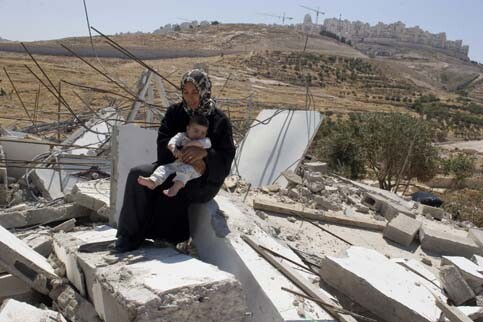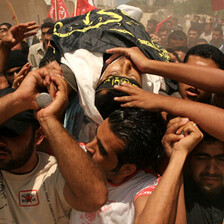The Electronic Intifada 22 June 2006

The Khaleel family sits on the remains of their house demolished by the Israeli army in the West Bank village of Um Toba near Jerusalem June 21, 2006. (MaanImages/Raoul Kramer)
In Israeli discourse, Israel is always presented as the side exercising restraint in its conflict with the Palestinians. This was true again for the events of the past week: As the Qassam rockets were falling on the Southern Israeli town of Sderot, it was “leaked” that the Israeli Minister of Defense had directed the army to show restraint. [1]
During the week of Israeli restraint, the army killed a Palestinian family who went on a picnic on the Beit Lahya beach in the Gaza Strip; after that, the army killed nine people in order to liquidate a Katyusha rocket. But in the discourse of restraint, the first killing does not count, because the army denied its involvement, and the second was deemed a necessary act of self-defense. After all, Israel is caught in the midst of Qassam attacks, and must defend its citizens. In this narrative, the fact that Israel is content merely to bombard the Gaza Strip from air, sea and land is a model of restraint and humanity that not many states could match.
But what is driving the Qassam attacks on Israel? For 17 months, since it declared a cease fire, Hamas has not been involved in firing Qassams. The other organizations have generally succeeded in launching only a few isolated Qassams. How did this evolve into an attack of something like 70 Qassams in three days?
The Israeli army has a long tradition of “inviting” salvoes of Qassams. In April of last year, Sharon took off to a meeting with Bush in which his central message was that Abbas is not to be trusted, has no control of the ground, and cannot be a partner for negotiations. The army took care to provide an appropriate backdrop for the meeting. On the eve of Sharon’s departure, on 9 April 2005, the Israeli army killed three youths on the Rafah border, who according to Palestinian sources were playing soccer there. This arbitrary killing inflamed a wave of anger in the Gaza Strip, which had been relatively quiet until then. Hamas responded to the anger on the street, and permitted its people to participate in the firing of Qassams. On the following two days, about 80 Qassams were fired, until Hamas restored calm. Thus, during the Sharon-Bush meeting, the world received a perfect illustration of the untrustworthiness of Abbas. [2]
At the beginning of last week (11 June), Olmert set out on a campaign of persuasion in Europe to convince European leaders that now, with Hamas in power, Israel definitely has no partner. The USA does not appear to need any convincing at the moment, but in Europe there is more reservation about unilateral measures. The Israeli army began to prepare the backdrop on the night of the previous Thursday (8 June 2006), when it “liquidated” Jamal Abu Samhanada, who had recently been appointed head of the security forces of the Interior Ministry by the Hamas government. It was entirely predictable that the action may lead to Qassam attacks on Sderot. Nevertheless, the army proceeded the following day to shell the Gaza coast (killing the Ghalya family and wounding tens of people), and succeeded in igniting the required conflagration, until Hamas again ordered its people, on 14 June, to cease firing.
This time, the show orchestrated by the army got a bit messed up. Pictures of the child Huda Ghalya succeeded in breaching the wall of Western indifference to Palestinian suffering. Even if Israel still has enough power to force Kofi Annan to apologize for casting doubt on Israel’s denial, the message that Hamas is the aggressive side in the conflict did not go unchallenged in the world this time. But the army has not given up. It appears determined to continue to provoke attacks that would justify bringing down the Hamas government by force, with Sderot paying the price.
Even though it is impossible to compare the sufferings of the residents of Sderot with the sufferings of the residents of Beit Hanoun and Beit Lahiya in the North of the Gaza Strip, on which 5,000 shells fell in the past month alone [3], my heart also goes out to the residents of Sderot. It is their destiny to live in fear and agony, because in the eyes of the army their suffering is necessary so that the world may understand that Israel is the restrained side in a war for its very existence.
Tanya Reinhart is a lecturer in linguistics, media and cultural studies at Tel Aviv University and the University of Utrecht. She is the author of several books, including Israel/Palestine: How to End the 1948 War (Seven Stories Press, 2002). This article was first published in Yediot Aharonot on June 21, 2006, and was translated from Hebrew by Mark Marshall (quotes and references added). Note: This op-ed went to press an hour before the Israeli air force killed three more children in a crowded street in North Gaza, on Tuesday, June 20.
Footnotes
1. On Monday, June 12, the headlines announced that the Defence Minister Peretz blocked an initiative of the army to launch a massive land offensive in Gaza (e.g. Amos Har’el and Avi Issacharoff, Ha’aretz, June 12, 2006). In the inside pages of the weekend papers, it turned out that this was a “media spin” produced by Peretz bureau “based on a security consultation held the previous night” (Avi Issacharoff and Amos Harel, Lost innocents, Ha’aretz, June 16-17, 2006).
2. This sequence of events is documented in detail in my book The Road Map to Nowhere, to appear in July, 2006 (Verso).
3. Alex Fishman, Senior security analyst of Yediot Aharonot reports that at the beginning “the artillery shelling of the Gaza strip was debated”, but then, “what started ten months ago with dozens of shells a month that were fired at open areas today reached astronomical numbers of shells. The battery that fired the six shells on Friday [June 9] fire an average of more than a thousand shells a week towards the north of the Strip. This means that the battery which has been placed there for four weeks has already fired about 5000 (!) shells” (Yediot Aharonot Saturday Supplement, June 16, 2006).
Related Links




